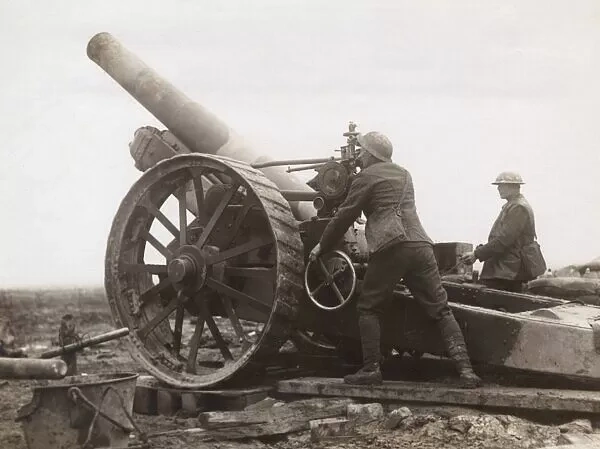
Range finding an 8 inch Howitzer on the battlefield during WWI. Imperial War Museum.
During World War I, the Royal Garrison Artillery (RGA) was a crucial component of the British Army responsible for providing heavy artillery support on the battlefield. The RGA played a significant role in the war, employing a wide range of artillery pieces to support infantry operations, conduct counter-battery fire, and carry out other vital tasks.
Key aspects of the Royal Garrison Artillery during World War I:
- Role and Organization: The RGA was a specialized branch of the British Army dedicated to operating and managing heavy artillery, including large-caliber guns, howitzers, and mortars. It was responsible for defending key locations, such as ports, cities, and other strategic positions, as well as providing artillery support to the British Expeditionary Force on the Western Front.
- Heavy Artillery: The RGA operated a variety of heavy artillery pieces, ranging from 4.5-inch howitzers to massive 15-inch and 9.2-inch guns. These guns were used for long-range bombardments, destroying enemy fortifications, disrupting enemy lines, and providing cover for infantry advances.
- Trench Warfare: In the context of trench warfare on the Western Front, the RGA’s role was crucial. They were tasked with softening enemy defenses before major offensives, aiming to create breaches in the enemy lines through intense and prolonged artillery barrages.
- Counter-Battery Fire: The RGA also engaged in counter-battery fire, targeting enemy artillery positions and attempting to neutralize or destroy them. This was a critical task to reduce the effectiveness of enemy artillery and protect British troops.
- Gas Attacks: During World War I, chemical warfare, particularly gas attacks, was employed by both sides. The RGA was responsible for deploying gas shells when required, though the use of chemical weapons was highly controversial and led to devastating consequences.
- Coast Defense: Apart from its role on the Western Front, the RGA also played a significant role in coastal defense, operating heavy coastal artillery to protect important ports and naval bases from enemy naval attacks.
- Involvement in Major Battles: The RGA was involved in numerous major battles of World War I, including the Battles of the Somme, Ypres, Passchendaele, and others. Their firepower and support were instrumental in some of these battles’ outcomes.
- Technical and Tactical Innovations: World War I brought about significant advancements in artillery technology and tactics. The RGA was at the forefront of these developments, learning to adjust fire more accurately, use new types of ammunition, and adapt to the evolving nature of warfare.
- Sacrifice and Casualties: The Royal Garrison Artillery suffered significant casualties during World War I. Operating heavy guns often put artillery crews in vulnerable positions, making them susceptible to enemy counter-fire.
- Post-War Legacy: After the war, the Royal Garrison Artillery continued to be a vital part of the British Army, evolving alongside military technology and doctrine. However, the devastation of World War I and subsequent developments in warfare would lead to further changes in artillery tactics and organization.
The Royal Garrison Artillery’s efforts during World War I were critical to the overall success of British operations and played a vital role in the complex and challenging trench warfare on the Western Front. The sacrifices and achievements of the RGA members are remembered and honored to this day.
